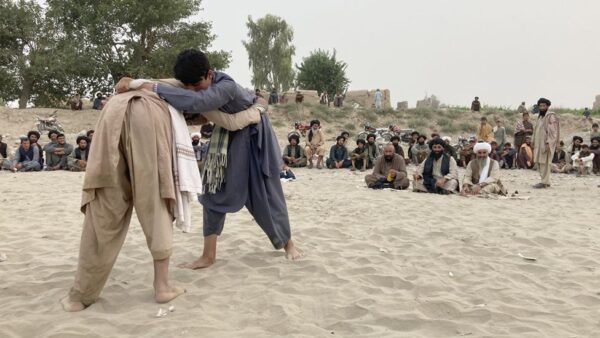
Afghanistan: Peace at a price in the Taliban’s heartlands
On a dusty land next to the Helmand River, along what was once one of the front lines of the war, two teenage boys were locked in a hug, trying to wrestle each other to the ground. Sitting in a wide circle, the audience looked excitedly when the afternoon light began to dim.
We were in the Sangin District in South Afghanistan, scenes of some of the deadliest clashes over the past two decades. Most cities are still debris, although a number of houses are being rebuilt when residents return home, enjoying their first peace of peace for years.
There are no women among the crowd: In this very conservative country, they are mostly stored behind a closed door. Many people here support the Taliban rebellion against the former Afghan government and the US troops who supported it, while others only relieve violence that interfere with their lives finally ended.
Life is very good now, people are happy,” said Lalai, who has arranged wrestling matches. “There is no freedom and there is no problem,” about other men.
Everyone you talk to here is influenced by war. “You will not find a house in the district without at least two or three martyrs,” Lalai told us.
Many Afghan residents felt very sad about the direction of this country taken by the Taliban. However, in rural areas, especially in the south and east – dominated by ethnic Pashhtun – there are many other people who support the Taliban or who feel life under their government is preferred than the life of war.
The conflict reminder is everywhere in: the debris of the house leveled by the US or the Afghan government air strike, as well as the scar on the road that leads to the capital of Helmand Lashkar Gah, which was left by the Taliban bomb.
In Lashkar Gah, everyone we talk to praise better security, but there are new battles in Afghan cities, against hunger.
Foreign funding used to sustain the previous government has been trimmed and the reserve of the Afghan Bank has been frozen since the Taliban took over last year’s power. Now poverty and malnutrition is increasing.
“I went to the roundabout when dawn to try and find a job as a laborer,” an old man told us, “but if even one person came to offer a job, the other 50 surrounded him first.”
The crowd gathered around us when we spoke, all complained of sharp increase to food prices and lack of opportunities.
Even when I said my prayer, I continued to think of my debt and how I would pay back,” said Haji Baridad, a building contractor. Still, he added, he likes the war ended. “I live outside the city and can’t travel at night, now I can … but I don’t get anything.”
The Taliban does have a level of support for original grassroots in Afghanistan, especially in places like Helmand, even though when they are contrary to democratic elections, it is not possible to measure it.
Helmand, however, is also one of the most controlled provinces in this country. We have been told that anyone openly criticized the arrest of the Taliban face or even worse.
In December 2021, Naveed Azimi, an English teacher, was detained by the Taliban in Helmand for writing a Facebook post that criticized the lack of salary for government employees. Not long after, his body was thrown away by the river.
Speaking on anonymous conditions, another local critic of the Taliban told the BBC that around 20 people had a total of being arrested for their social media activities.
You can’t say anything at all,” he said, describing how some were threatened while others were detained in prison. “The Taliban has various types of torture for them, hit them with cables and pipes, holding their heads under water.”

